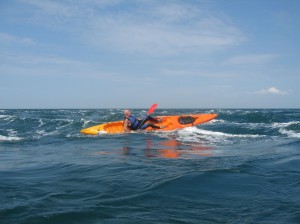Kayaking in tide races and overfalls
Today I was doing some 1:1 kayak coaching in the tide race at Tour de Rozel (or white rock) on the north coast of Jersey. This is a cracking good spot as the water is fast but with some good breakouts to regroup and coach.
Tour de Rozel works best on about 1 hour after low tide on tides between 32ft-35ft. Above 35ft and the tide rises very too fast and you do not have much time to ‘play’.
Tide race kayaking tips
When to paddle in tide races
To often people try to develop skills in large tide races where paddling technique and skills soon turn into a battle for survival.
Start in small and slow moving tide races perhaps at the start of the flood or ebb so that you get time as it begins to build up. Neap tides may be a good starting point before heading out on the big spring tides when the water will be tanking through.
Make every paddle stroke count
If you are going to play in tide races it need not be a mass of whirling paddles and rapid movement. Try to slow down and make every paddle stroke count.
Relax in your sea kayak
You cannot respond to every movement of the kayak. Try to let the kayak move beneath you.
Be committed
If you do have to lock out or hold an edge then make it positive and committed. Rough water is not the time to be half hearted.
Connect with your kayak
Foot rests,thigh braces and seat contact needs to be positive and well defined.
Below the waste
Focus on what your body is doing below the waste. To often paddlers only think it is the upper body that is important. Good paddle technique runs form the tip of your toes to the end of your fingers.
Develop your kayak edging skills
Check out your inside and outside edging skills before you start messing about in moving water. Train in calm water inside and outside edges.
Be dynamic with your paddle strokes
Use paddle strokes in the forward sector of the kayak rather than putting the paddle blade behind you.
A low brace may be comforting but it will slow down the kayak and you’ll find it harder to manoeuvre. This may result in you spending more time where you do not want to be.
Forward and dynamic strokes get you out of there.
Paddle faster or slower than the water
If you paddle a canoe this is a great way to work a rapid on the river. You can do the same with a sea kayak.
Whether you go faster or slower than the water you are in control. Stop paddling and you are now moving at the waters speed. The water is in control and will do what it wants with you.
The Falstaff principle
Doing Henry IV part one years ago I recall Falstaff saying “discretion is the better part of valour”. I often suggest this option in big water. If you want to get out of a spot then you’ll need to put power into your paddle stokes. Stop tickling the water and paddle in a focussed manner to get out of there.
Make every paddle stroke count
Imagine every time you put the paddle in the water it will cost you £100. Use your paddle skills wisely. Lean forward,edge, drive, power your kayak through the water.
Practice
Start on flat water checking your ability to edge. Hold a lean in a tilted turn. Practice inside and outside pivot turns before moving into tide races.
Try using a short kayak
A great way to tune up your reactions and confidence.
Change speed
If you only have one “gear” when paddling it is going to be tricky to quickly change your paddle speed and style.
Tide races demand constant changes of paddle styles. This is a good reason to get used to paddling with high and low angle paddle styles.
Use your body
Lean forward to add extra power and accelerate. Lean back to slow down. Practice both while edging. Surf is a great place to develop these techniques. Just make sure you choose small surf.
Dress for immersion
Wearing the right kit will encourage you to try that bit more. I’ve started coaching students with our dry suits. A great way to remove worries about falling into April waters.
Decide what you are going to do
Set a goal or target every time you go into the tide race. That way you know what you want to do.
Whether it is to ferry glide across, run the race, or try and surf a standing wave, advance planning will make you consider the skills you may need to use.
Be prepared to change plan once in a tide race. That is part f the fun.
Safety
Make sure there is a good escape or empty out area near by. Ensure you are with others who can handle deep water rescues in possibly rough seas.
Wear a helmet
Rocks and other kayaks are a potential hazard.
Why bother?
One day you might find yourself having to go through a tide race so it is handy to know you can handle it.
Tide races are a good place to link skills together. Great for the confidence and guaranteed to erase any stresses from work




